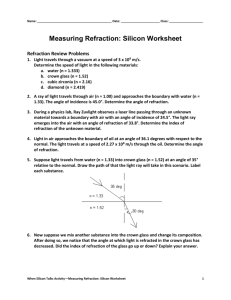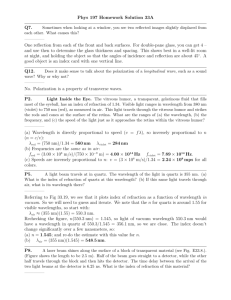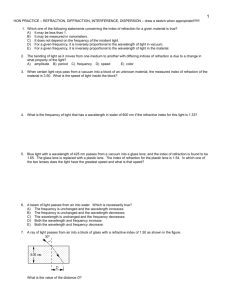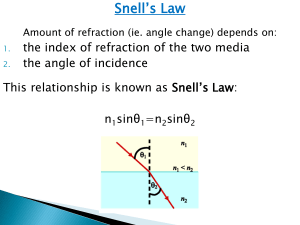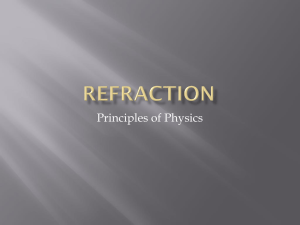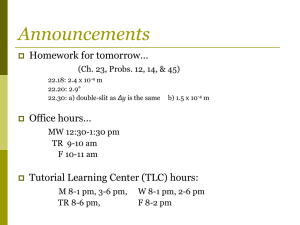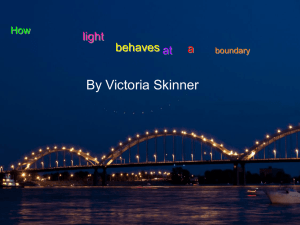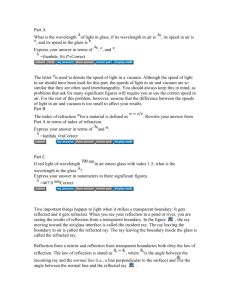Ch. 35 Clicker Questions . View as
advertisement
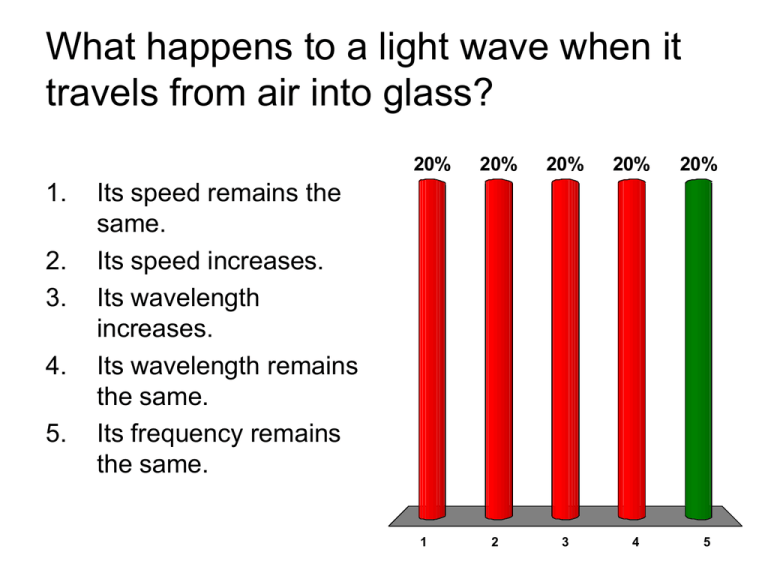
What happens to a light wave when it travels from air into glass? 20% 1. 2. 3. 4. 5. 20% 20% 20% 3 4 20% Its speed remains the same. Its speed increases. Its wavelength increases. Its wavelength remains the same. Its frequency remains the same. 1 2 5 A source emits monochromatic light of wavelength 495 nm in air. When the light passes through a liquid, its wavelength reduces to 434 nm. What is the liquid’s index of refraction? 20% 1. 2. 3. 4. 5. 20% 20% 20% 20% 1.26 1.49 1.14 1.33 2.03 1. 2. 3. 4. 5. Carbon disulfide (n = 1.63) is poured into a container made of crown glass (n = 1.52). What is the critical angle for total internal reflection of a light ray in the liquid when it is incident on the liquid-to-glass surface? 20% 1. 2. 3. 4. 5. 20% 20% 20% 3 4 20% 89.2° 68.8° 21.2° 1.07° 43.0° 1 2 5 What is the order of magnitude of the time interval required for light to travel 10 km as in Galileo’s attempt to measure the speed of light? 25% 1. 2. 3. 4. 25% 25% 2 3 25% several seconds several milliseconds several microseconds several nanoseconds 1 4 In each of the following situations, a wave passes through an opening in an absorbing wall. Rank the situations in order from the one in which the wave is best described by the ray approximation to the one in which the wave coming through the opening spreads out most nearly equally in all directions in the hemisphere beyond the wall. (a) The sound of a low whistle at 1 kHz 20% 20% 20% 20% 20% passes through a doorway 1 m wide. (b) Red light passes through the pupil of your eye. (c) Blue light passes through the pupil of your eye. (d) The wave broadcast by an AM radio station passes through a doorway 1 m wide. (e) An x-ray passes through the space between bones in your elbow joint. 1. 2. 3. 4. 5. e, b, d, c, a b, c, a, d, e c, e, b, d, a d, c, a, e, b e, c, b, a, d 1 2 3 4 5 The index of refraction for water is about 4/3. What happens as a beam of light travels from air into water? 20% 1. 2. 3. 4. 5. 20% 20% 20% 3 4 20% Its speed increases to 4/3 c, and its frequency decreases. Its speed decreases to 3/4 c, and its wavelength decreases by a factor of 3/4. Its speed decreases to 3/4 c, and its wavelength increases by a factor of 4/3. Its speed and frequency remain the same. Its speed decreases to 3/4 c, and its frequency increases. 1 2 5 Light can travel from air into water. Some possible paths for the light ray in the water are shown in Figure OQ35.7. Which path will the light most likely follow? 20% 20% 20% 20% 3 4 20% [Figure OQ35.7] 1. 2. 3. 4. 5. A B C D E 1 2 5 A light wave moves between medium 1 and medium 2. Which of the following are correct statements relating its speed, frequency, and wavelength in the two media, the indices of refraction of the media, and the angles of incidence and refraction? More than one statement may be correct. 20% 1. 2. 3. 4. 5. 20% 20% 20% 3 4 20% v1/sin θ1 = v2/sin θ2 csc θ1/n1 = csc θ2/n2 λ1/sin θ1 = λ2/sin θ2 f1/sin θ1 = f2/sin θ2 n1/cos θ1 = n2/cos θ2 1 2 5 A light ray containing both blue and red wavelengths is incident at an angle on a slab of glass. Which of the sketches in Figure OQ35.9 represents the most likely outcome? 20% 20% 20% 20% 3 4 20% [Figure OQ35.9] 1. 2. 3. 4. A B C D 5. none of them 1 2 5 Can light undergo total internal reflection at a smooth interface between air and water? If so, in which medium must it be traveling originally? 25% 1. 2. 3. 4. 25% 25% 2 3 25% yes; water yes; air yes; it doesn't matter no 1 4 Can sound undergo total internal reflection at a smooth interface between air and water? If so, in which medium must it be traveling originally? 25% 1. 2. 3. 4. 25% 25% 2 3 25% yes; water yes; air yes; it doesn't matter no 1 4 Light traveling in a medium of index of refraction n1 is incident on another medium having an index of refraction n2. Under which of the following conditions can total internal reflection occur at the interface of the two media? 20% 1. 2. 3. 4. 5. 20% 20% 20% 3 4 20% The indices of refraction have the relation n2 > n1. The indices of refraction have the relation n1 > n2. Light travels slower in the second medium than in the first. The angle of incidence is less than the critical angle. The angle of incidence must equal the angle of refraction. 1 2 5 Suppose you find experimentally that two colors of light, A and B, originally traveling in the same direction in air, are sent through a glass prism, and A changes direction more than B. Which travels more slowly in the prism, A or B? 1. A 2. B 3. There is insufficient information to determine which moves more slowly. 33% 1 33% 2 33% 3 The core of an optical fiber transmits light with minimal loss if it is surrounded by what? 20% 1. 2. 3. 4. 5. 20% 20% 20% 3 4 20% water diamond air glass fused quartz 1 2 5 Which color light refracts the most when entering crown glass from air at some incident angle θ with respect to the normal? 20% 1. 2. 3. 4. 5. 20% 20% 20% 3 4 20% violet blue green yellow red 1 2 5 A light ray travels from vacuum into a slab of material with index of refraction n1 at incident angle θ with respect to the surface. It subsequently passes into a second slab of material with index of refraction n2 before passing back into vacuum again. The surfaces of the different materials are all parallel to one another. As the light exits the second slab, what can be said of the final angle Φ that the outgoing light makes with the normal? 20% 20% 20% 20% 20% 1. 2. 3. 4. 5. Φ>θ Φ<θ Φ=θ The angle depends on the magnitudes of n1 and n2. The angle depends on the wavelength of the light. 1 2 3 4 5


